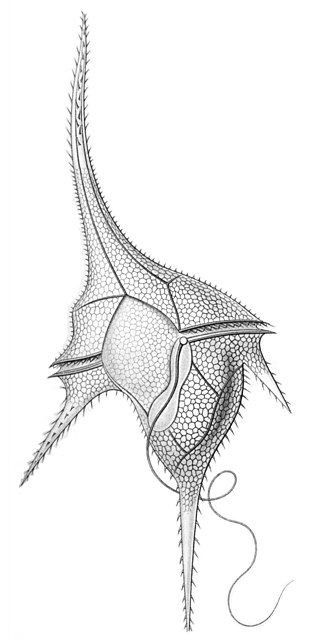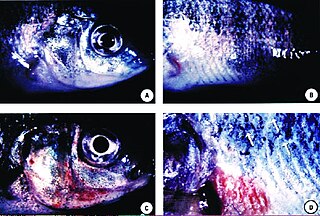
The dinoflagellates are a monophyletic group of single-celled eukaryotes constituting the phylum Dinoflagellata and are usually considered protists. Dinoflagellates are mostly marine plankton, but they also are common in freshwater habitats. Their populations vary with sea surface temperature, salinity, and depth. Many dinoflagellates are photosynthetic, but a large fraction of these are in fact mixotrophic, combining photosynthesis with ingestion of prey.

The Noctilucales are an order of marine dinoflagellates. They differ from most others in that the mature cell is diploid and its nucleus does not show a dinokaryotic organization. They show gametic meiosis.

Pfiesteria piscicida is a dinoflagellate species of the genus Pfiesteria that some researchers claim was responsible for many harmful algal blooms in the 1980s and 1990s on the coast of North Carolina and Maryland. North Carolinian media in the 1990s referred to the organism as the cell from hell. It is known to populate estuaries. Piscicida means "fish-killer".
Ciguatera fish poisoning (CFP), also known as ciguatera, is a foodborne illness caused by eating reef fish contaminated with ciguatoxins. Such individual fish are said to be ciguatoxic. Symptoms may include diarrhea, vomiting, numbness, itchiness, sensitivity to hot and cold, dizziness, and weakness. The onset of symptoms varies with the amount of toxin eaten. If a lot of toxins are consumed symptoms may appear within half an hour. If a low amount of toxins are consumed symptoms make take a few days to appear. Diarrhea may last up to four days. Symptoms may last a few weeks to a few months. Heart problems such as slow heart rate and low blood pressure may occur.

Predatory dinoflagellates are predatory heterotrophic or mixotrophic alveolates that derive some or most of their nutrients from digesting other organisms. About one half of dinoflagellates lack photosynthetic pigments and specialize in consuming other eukaryotic cells, and even photosynthetic forms are often predatory.
Alexandrium fundyense is a species of dinoflagellates. It produces toxins that induce paralytic shellfish poisoning (PSP), and is a common cause of red tide. A. fundyense regularly forms massive blooms along the northeastern coasts of the United States and Canada, resulting in enormous economic losses and public health concerns.

Gambierdiscus toxicus is a species of photosynthetic unicellular eukaryote belonging to the Alveolata, part of the SAR supergroup. It is a dinoflagellate which can cause the foodborne illness ciguatera, and is known to produce several natural polyethers including ciguatoxin, maitotoxin, gambieric acid, and gambierol. The species was discovered attached to the surface of brown macroalgae.
Gonyaulax is a genus of dinoflagellates with the type species Gonyaulax spinifera Diesing. Gonyaulax belongs to red dinoflagellates and commonly causes red tides. It can produce yesotoxins: for example, strains of Gonyaulax spinifera from New Zealand are yessotoxin producers.
Luciella masanensis is a species of heterotrophic marine dinoflagellates.
Gambierdiscus pacificus is a species of toxic dinoflagellate. It is 67–77 μm long and 60–76 μm wide dorsoventrally and its surface is smooth. It is identified by a four-sided apical pore plate surrounded by 30 round pores. Its first plate occupies 20% of the width of the hypotheca.
Gambierdiscus australes is a species of toxic dinoflagellate. It is 76–93 μm long and 65–85 μm wide dorsoventrally and its surface is smooth. It is identified by a broad ellipsoid apical pore plate surrounded by 31 round pores. Its first plate occupies 30% of the width of the hypotheca.
Gambierdiscus polynesiensis is a species of toxic dinoflagellate. It is 68–85 μm long and 64–75 μm wide dorsoventrally and its surface is smooth. It is identified by a large triangular apical pore plate, a narrow fish-hook opening surrounded by 38 round pores, and a large, broad posterior intercalary plate. Its first plate occupies 60% of the width of the hypotheca.
Karenia bicuneiformis, also known as Karenia bidigitata is a microbial species from the genus Karenia, which are dinoflagellates. It was first discovered in New Zealand.
Karlodinium ballantinum is a species of unarmored dinoflagellates from the genus Karlodinium. It was first isolated from the Australian region of the Southern Ocean. It is small-sized and is characterized by its very short apical groove. It is considered potentially ichthyotoxic.
Gambierdiscus caribaeus is a species of toxic dinoflagellate, which among others causes ciguatera fish poisoning. It is photosynthetic and epibenthic.
Gambierdiscus carolinianus is a species of toxic dinoflagellate, which among others causes ciguatera fish poisoning. It is photosynthetic and epibenthic.
Gambierdiscus ruetzleri is a species of toxic dinoflagellates, which among others causes ciguatera fish poisoning. It is photosynthetic and epibenthic.

Gambierdiscus is a genus of marine dinoflagellates that produce ciguatoxins, a type of toxin that causes the foodborne illness known as ciguatera. They are usually epiphytic on macroalgae growing on coral reefs.
Coolia is a marine dinoflagellate genus in the family Ostreopsidaceae. It was first described by Meunier in 1919. There are currently seven identified species distributed globally in tropical and temperate coastal waters. Coolia is a benthic or epiphytic type dinoflagellate: it can be found adhered to sediment or other organisms but it is not limited to these substrates. It can also be found in a freely motile form in the water column. The life cycle of Coolia involves an asexual stage where the cell divides by binary fission and a sexual stage where cysts are produced. Some of the species, for example, Coolia tropicalis and Coolia malayensis, produce toxins that can potentially cause shellfish poisoning in humans.
Ciguatoxin 1 or CTX-1 is a toxic chemical compound, the most common and potent type in the group of ciguatoxins. It is a large molecule consisting of polycyclic polyethers that can be found in certain types of fish in the Pacific Ocean. The compound is produced by Dinoflagellates Gambierdiscus toxicus and is passed on through the food chain by fish. The compound has no effect in fish but is toxic to humans.




